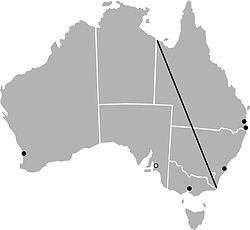AFL Grand Final location debate
During this time, the location debate centred around the fairness of the grand final being staged permanently in Victoria after the league had spread nationally.
Early VFL Grand Finals were played at different neutral venues chosen by the league's match committee a week in advance.
The portion of the gate and privileges for cricket club members demanded by grounds landlords was considered by the league's match committee in its annual choice of venue.
[3] In 1929, the MCC began paying the VFL lump sums for the right to host the finals and grand final each year – similar to an agreement it already had with the Victorian Cricket Association for exclusive rights to stage international cricket – and the lump sum partly covered the cost of its members' entry.
[6][7] The ground was not used for the grand final between 1942 and 1945, as it was required to be used by the Australian military after its entry into the Pacific campaign of World War II.
Initially, it was blocked on the basis that the higher crowd required improved public facilities and transport in the surrounding area, which the VFL agreed to fund;[14] but by the end of 1982, the government stated openly that it preferred and was committed to keeping the grand final at Melbourne Cricket Ground, and thus rejected VFL Park expansion plans.
Both had invested heavily in the ageing facilities at the Melbourne Cricket Ground, and grand final entry was also a noted incentive for MCC memberships.
[32] Another common argument in recent times regarding the rotation of the AFL Grand Final venue is for the sake of growing the game in the non-traditional markets of Australian rules football.
Many football writers argue that the AFL cannot claim to be a full national competition until the championship deciding match is shared around the country regularly.
[35] It is argued that by moving the AFL Grand Final around Australia it will give an incentive to state governments to invest money into Australian rules football stadia.
[37] In 2018, when the Victorian government announced the $500 million investment in the Melbourne Cricket Ground and other Victorian football infrastructure which triggered the extension of the grand final contract to 2057, it acknowledged that it was motivated by a desire to protect the economic windfall Victoria derives from hosting the grand final – noting the strong investment in stadiums by all of the other mainland states and the need to remain competitive with them.
[39] This compares to the $12.5 million dollars in benefits which the Victorian government is estimated to deliver to the AFL each year as part of its deal to host the game until 2059.
[40] A key argument in regards to fairness centres on the fact that non-Victorian clubs must always carry the travel burden of the grand final, and that MCG tenant clubs in particular have the benefit of hosting the premiership decider at their home ground, some playing up to seventeen games on the ground each year,[42][43] making the arrangement the biggest handicap against non-Victorian sides being able to win the premiership.
[46] The AFL acknowledged the home state imbalance in its 2018 contract renegotiation by including some balancing provisions: that interstate clubs be scheduled to play at least two home-and-away games at the venue annually, be granted training access to the ground during the year, and be chartered flights during grand final week.
[48][49] This has been outright ruled out by league CEO Gillon McLachlan because preparation for the grand final – including all of the spectator and corporate events which accompany it, contributing significantly to both the tradition and revenue of the game respectively – require months or years of planning, making it both impractical and financially costly to leave the venue undecided until after preliminary final weekend.
[50] The Melbourne Cricket Ground remains the highest capacity stadium in Australia, and thus provides the greatest opportunity for spectators to attend.
This remains a strong argument in favour of the current arrangement,[29] and part of the AFL's stated model is to maximise the game's in-person attendance.
[50] A critique of this view is that, from the pure perspective of its audience numbers, the AFL Grand Final is primarily a television event.
[51] But there is also an economic argument in favour of the high capacity, which notes that the ability to sell corporate grand final ticket packages, which are most plentiful at the large venue, is a significant revenue earner for both the league and the clubs, and that under present business models this revenue is a critical part of the game's overall cash flow; the AFL made a $19 million profit on the 2016 grand final alone, mostly from corporate packages.







